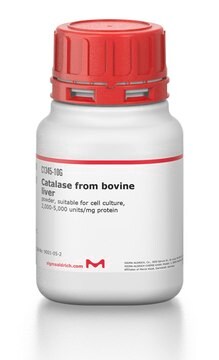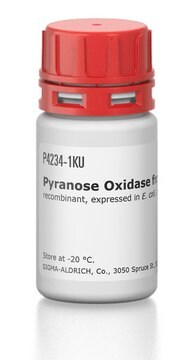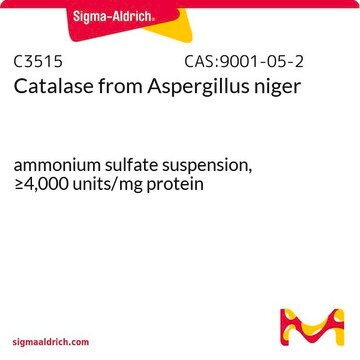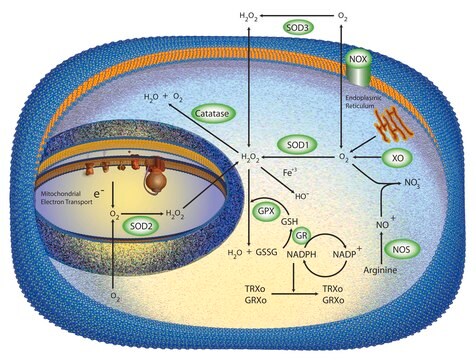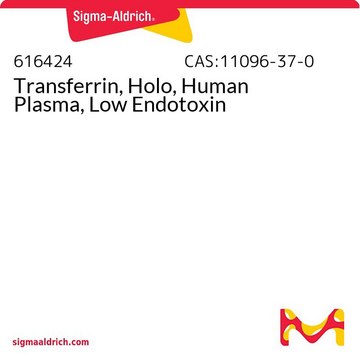C40
Catalase from bovine liver
lyophilized powder, ≥10,000 units/mg protein
Synonym(s):
H2O2:H2O2 oxidoreductase
Sign Into View Organizational & Contract Pricing
All Photos(2)
About This Item
Recommended Products
form
lyophilized powder
Quality Level
specific activity
≥10,000 units/mg protein
mol wt
tetramer ~250 kDa
contains
≤0.2 wt. % Thymol
isoelectric point
5.4
solubility
50 mM potassium phosphate buffer, pH 7.0: soluble 2.0 mg/mL
UniProt accession no.
shipped in
wet ice
storage temp.
−20°C
InChI
1S/C9H10O3/c1-2-12-9(11)7-3-5-8(10)6-4-7/h3-6,10H,2H2,1H3
InChI key
NUVBSKCKDOMJSU-UHFFFAOYSA-N
Gene Information
cow ... CAT(280743)
Looking for similar products? Visit Product Comparison Guide
General description
Research Area: Cell Signaling
Catalase from bovine liver is a tetramer consisting of 4 equal subunits each with a 60 kDa molecular weight. Each of these subunits contains iron bound to a protoheme IX group. The enzyme will also strongly bind to NADP, where NADP and the heme group are within 13.7 angstroms.
Catalase from bovine liver is a tetramer consisting of 4 equal subunits each with a 60 kDa molecular weight. Each of these subunits contains iron bound to a protoheme IX group. The enzyme will also strongly bind to NADP, where NADP and the heme group are within 13.7 angstroms.
Application
Catalase acts as a natural antioxidant to study the roles of reactive oxygen species in gene expression and apoptosis. It has also been used to protect against oxidative damage to proteins, lipids, and nucleic acids. Industrially, catalzes have been used to remove hydrogen peroxide added to milk and cheese, in textile bleaching, and to examine its positive effects on the viability of DNA-repair mutants of E. coli.
Catalase from bovine liver may be used:
Catalase from bovine liver may be used:
- to prepare H2O2-O2 based biocathode for applications in glucose biofuel cells
- to study the kinetic properties and storage stability of catalase immobilized on to florisil
- in glutathione-mediated superoxide generation in an aqueous solution
Biochem/physiol Actions
Catalase activity is constant over the pH range of 4.0-8.5. The enzyme activity is inhibited by 3-amino-1-H-1,2,4 triazole, cyanide, azide, hydroxylamine, cyanogen bromide, 2-mercaptoethanol, dithiothreitol, dianisidine, and nitrate. Incubation of catalase with ascorbate or ascorbate/Cu2+ results in degradation of the catalase molecule.
Catalase, an antioxidant enzyme found in all aerobic organisms, catalyzes the degradation of hydrogen peroxide, a byproduct of metabolic processes, into less harmful water and oxygen. It can also react with alkylhydrogen peroxides, such as methylperoxide and ethylperoxide and the second H2O2 molecule can be replaced by methanol, ethanol, propanol, formate and nitrate as a hydrogen donor. Catalase enzyme uses either iron (Fe) or manganese (Mn) as cofactor, and are classified as Fe-CAT or Mn-CAT.
Caution
Solutions of catalse should not be frozen. Frozen solution will result in a 50-70% loss of activity.
Unit Definition
One unit will decompose 1.0 μmole of H2O2 per min at pH 7.0 at 25 °C, while the H2O2 concentration falls from 10.3 to 9.2 mM, measured by the rate of decrease of A240.
Other Notes
The protein content is determined by the Biuret method. In the product specifications, a protein content >= 70% is guaranteed. The impurities are not analyzed. The only other content specification is the concentration of Thymol, <= 0.2% wt.
inhibitor
Product No.
Description
Pricing
Signal Word
Danger
Hazard Statements
Precautionary Statements
Hazard Classifications
Resp. Sens. 1
Storage Class Code
11 - Combustible Solids
WGK
WGK 1
Flash Point(F)
Not applicable
Flash Point(C)
Not applicable
Personal Protective Equipment
dust mask type N95 (US), Eyeshields, Gloves
Choose from one of the most recent versions:
Already Own This Product?
Find documentation for the products that you have recently purchased in the Document Library.
Customers Also Viewed
Emilia M Sogin et al.
mSystems, 4(6) (2019-12-12)
Microbial communities exchange molecules with their environment, which plays a major role in regulating global biogeochemical cycles and climate. While extracellular metabolites are commonly measured in terrestrial and limnic ecosystems, the presence of salt in marine habitats limits the nontargeted
Saskia F Erttmann et al.
Nature communications, 10(1), 3493-3493 (2019-08-04)
Hydrogen peroxide (H2O2) has a major function in host-microbial interactions. Although most studies have focused on the endogenous H2O2 produced by immune cells to kill microbes, bacteria can also produce H2O2. How microbial H2O2 influences the dynamics of host-microbial interactions
Francesca Mancini et al.
Molecular cancer, 16(1), 55-55 (2017-03-09)
Many tumor-related factors have shown the ability to affect metabolic pathways by paving the way for cancer-specific metabolic features. Here, we investigate the regulation of mTORC1 by MDM4, a p53-inhibitor with oncogenic or anti-survival activities depending on cell growth conditions.
Fujun Luo et al.
Nature communications, 12(1), 2380-2380 (2021-04-24)
Diverse signaling complexes are precisely assembled at the presynaptic active zone for dynamic modulation of synaptic transmission and synaptic plasticity. Presynaptic GABAB-receptors nucleate critical signaling complexes regulating neurotransmitter release at most synapses. However, the molecular mechanisms underlying assembly of GABAB-receptor
Afra Khiralla et al.
Microorganisms, 8(9) (2020-09-10)
An endophytic fungus isolated from Vernonia amygdalina, a medicinal plant from Sudan, was taxonomically characterized as Curvularia papendorfii. Ethyl acetate crude extract of C. papendorfii revealed an important antiviral effect against two viral pathogens, the human coronavirus HCoV 229E and
Our team of scientists has experience in all areas of research including Life Science, Material Science, Chemical Synthesis, Chromatography, Analytical and many others.
Contact Technical Service

